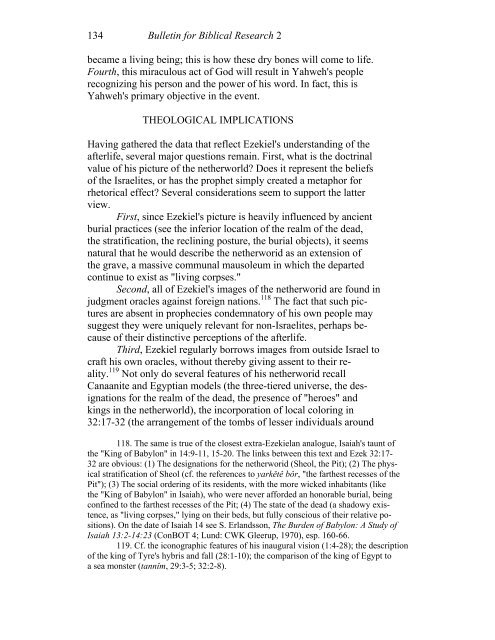Beyond the Grave - Institute for Biblical Research
Beyond the Grave - Institute for Biblical Research
Beyond the Grave - Institute for Biblical Research
Create successful ePaper yourself
Turn your PDF publications into a flip-book with our unique Google optimized e-Paper software.
134 Bulletin <strong>for</strong> <strong>Biblical</strong> <strong>Research</strong> 2<br />
became a living being; this is how <strong>the</strong>se dry bones will come to life.<br />
Fourth, this miraculous act of God will result in Yahweh's people<br />
recognizing his person and <strong>the</strong> power of his word. In fact, this is<br />
Yahweh's primary objective in <strong>the</strong> event.<br />
THEOLOGICAL IMPLICATIONS<br />
Having ga<strong>the</strong>red <strong>the</strong> data that reflect Ezekiel's understanding of <strong>the</strong><br />
afterlife, several major questions remain. First, what is <strong>the</strong> doctrinal<br />
value of his picture of <strong>the</strong> ne<strong>the</strong>rworld? Does it represent <strong>the</strong> beliefs<br />
of <strong>the</strong> Israelites, or has <strong>the</strong> prophet simply created a metaphor <strong>for</strong><br />
rhetorical effect? Several considerations seem to support <strong>the</strong> latter<br />
view.<br />
First, since Ezekiel's picture is heavily influenced by ancient<br />
burial practices (see <strong>the</strong> inferior location of <strong>the</strong> realm of <strong>the</strong> dead,<br />
<strong>the</strong> stratification, <strong>the</strong> reclining posture, <strong>the</strong> burial objects), it seems<br />
natural that he would describe <strong>the</strong> ne<strong>the</strong>rworid as an extension of<br />
<strong>the</strong> grave, a massive communal mausoleum in which <strong>the</strong> departed<br />
continue to exist as "living corpses."<br />
Second, all of Ezekiel's images of <strong>the</strong> ne<strong>the</strong>rworid are found in<br />
judgment oracles against <strong>for</strong>eign nations. 118 The fact that such pic-<br />
tures are absent in prophecies condemnatory of his own people may<br />
suggest <strong>the</strong>y were uniquely relevant <strong>for</strong> non-Israelites, perhaps be-<br />
cause of <strong>the</strong>ir distinctive perceptions of <strong>the</strong> afterlife.<br />
Third, Ezekiel regularly borrows images from outside Israel to<br />
craft his own oracles, without <strong>the</strong>reby giving assent to <strong>the</strong>ir re-<br />
ality. 119 Not only do several features of his ne<strong>the</strong>rworid recall<br />
Canaanite and Egyptian models (<strong>the</strong> three-tiered universe, <strong>the</strong> des-<br />
ignations <strong>for</strong> <strong>the</strong> realm of <strong>the</strong> dead, <strong>the</strong> presence of "heroes" and<br />
kings in <strong>the</strong> ne<strong>the</strong>rworld), <strong>the</strong> incorporation of local coloring in<br />
32:17-32 (<strong>the</strong> arrangement of <strong>the</strong> tombs of lesser individuals around<br />
118. The same is true of <strong>the</strong> closest extra-Ezekielan analogue, Isaiah's taunt of<br />
<strong>the</strong> "King of Babylon" in 14:9-11, 15-20. The links between this text and Ezek 32:17-<br />
32 are obvious: (1) The designations <strong>for</strong> <strong>the</strong> ne<strong>the</strong>rworid (Sheol, <strong>the</strong> Pit); (2) The phys-<br />
ical stratification of Sheol (cf. <strong>the</strong> references to yarkĕtê bôr, "<strong>the</strong> far<strong>the</strong>st recesses of <strong>the</strong><br />
Pit"); (3) The social ordering of its residents, with <strong>the</strong> more wicked inhabitants (like<br />
<strong>the</strong> "King of Babylon" in Isaiah), who were never af<strong>for</strong>ded an honorable burial, being<br />
confined to <strong>the</strong> far<strong>the</strong>st recesses of <strong>the</strong> Pit; (4) The state of <strong>the</strong> dead (a shadowy exis-<br />
tence, as "living corpses," lying on <strong>the</strong>ir beds, but fully conscious of <strong>the</strong>ir relative po-<br />
sitions). On <strong>the</strong> date of Isaiah 14 see S. Erlandsson, The Burden of Babylon: A Study of<br />
Isaiah 13:2-14:23 (ConBOT 4; Lund: CWK Gleerup, 1970), esp. 160-66.<br />
119. Cf. <strong>the</strong> iconographic features of his inaugural vision (1:4-28); <strong>the</strong> description<br />
of <strong>the</strong> king of Tyre's hybris and fall (28:1-10); <strong>the</strong> comparison of <strong>the</strong> king of Egypt to<br />
a sea monster (tannîm, 29:3-5; 32:2-8).

















